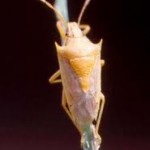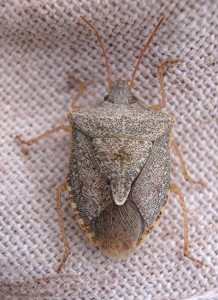I’ve had several reports of an unusual number of stink bugs in wheat. Most people are indicating that brown stink bug is what they are seeing, but rice stink bugs and green stink bugs will also often be present. Rather than reinventing the wheel, I will refer you to the comments by my colleague in Mississippi who beat me to the punch (see below). The long and short of it is that, unless present in very high numbers, treating for stink bugs is not recommended. They will feed on heads, but wheat can tolerate this injury with little difficulty. However, their presence in relatively large numbers does raise some concern for seedling corn. In corn less than 24 inches tall, stink bugs can feed through the stalk and kill the growing point of plants. Treatment in corn is recommended if more than 10% of plants are infested, but you will not have to worry about rice stink bugs in corn.
MSU Blog Article, Dr. Angus Catchot, April 13, 2011 (http://www.mississippi-crops.com/):
“We are beginning to see stink bugs show up in some wheat fields in the delta. It is not uncommon to find stink bugs in wheat after head emergence. However, it takes extremely high numbers to cause economic damage to heading wheat. With this in mind, seeing high numbers of stink bugs while walking a wheat field may seem alarming, but it takes a lot of stink bugs to cause economic damage. Research from the early 80’s showed that the milk stage of development is most susceptible to damage from stink bugs by reducing grain weight and germination. Current stink bug thresholds for wheat are 1 stinkbug/5-10 heads in the milk and soft dough stage. Once wheat reaches the hard dough stage the likelihood of damage from stink bug is diminished greatly. At this time the predominant stink bugs being found in Mississippi are rice and brown stink bugs. Because we do not generally treat a lot of wheat for stink bugs, wheat can actually harbor lots of stink bugs that will eventually move out into corn and group four soybeans when the wheat begins to hit hard dough. I have had several reports this week of stink bugs that are at and above threshold levels on field borders but populations tend to be lower away from field edges. Be sure and scout adjacent corn fields closely for sting bugs.”
I’ve included some pictures of adult brown and rice stink bugs below. Rice stink bugs are about one-half the size of brown stink bugs, and they have forward pointing spines on their shoulders.



